
Home page
Quantum computer fake news
Fake quantum supremacy and simulator
Quantum computer's supremacy is fake, useless, based on unreal parallel-universe simultaneous calculations.

(Fig.S) Overhyped fake news always claims "scalable quantum computers", which is a total lie.

Today's quantum computers have only less than 200 qubits (= one qubit or one quantum bit can take only 0 or 1 value ), which are still Not quantum computers, despite an incredible amount of overhyped fake news and meaningless breakthroughs.
A practical quantum computer is said to need more than millions of qubits, which is impossible to realize forever.
This-4~5th-paragraphs (5/11/2025) say -- Useless quantum computer
"Qubits remain fragile. Error correction is a monumental challenge,.. Scalable architectures are still experimental – we just don't have quantum computers big enough to do anything useful"
This-4th-paragraph (2024) says -- Million qubits impossible
"For a quantum computer to be practical, millions of qubits must be accommodated on a single chip. The most advanced quantum computers today have only a few hundred qubits, meaning they can only perform calculations that are already possible (and often more efficient) on conventional (= classical ) computers.." ← No quantum advantage
This-8th-last-paragraph (2024) says -- Useless quantum computer
"Willow is still well too small to do useful calculations and that quantum computers will require millions of qubits to solve really important industry problems. Willow has 105 qubits."
This-19~21th paragraphs say -- Million qubits needed
"All together, we will need a few million qubits to make quantum computers perform useful work that is also reliable."
This-2nd-paragraph (8/12/2025) says -- Million qubit challenge
"Scaling from the fewer-than-200-qubit prototypes seen today to the million-qubit threshold most experts believe is needed for practical use has been one of the field's hardest problems ( this-middle~lower )."
Even the useless publicity-stunt = IBM's largest 1121-qubit Condor falls far short of millions of qubits required for a real practical quantum computer.
This-last (2025) says -- Useful million qubits impossible
"Google's new Willow chip has 105 qubits. Microsoft's Majorana chip has eight. IBM's Starling plans to have 200 qubits (= still unrealized ). Amazon's Ocelot chip has 14 qubits."
"Google and Microsoft say a truly useful quantum computer will need 1 million qubits." ← Today's quantum computers with far smaller numbers of qubits are fake, useless.
Hiding the current deadend hopeless quantum computers needs an incredible amount of overhyped fake news baselessly claiming "these breakthrough (= fake ) researches will lead to scalable quantum computers in near future, as shown in (deceptive) roadmaps !"
(Fig.M) Quantum computers are impractical forever, contrary to overhyped fake news, prospects, roadmaps.
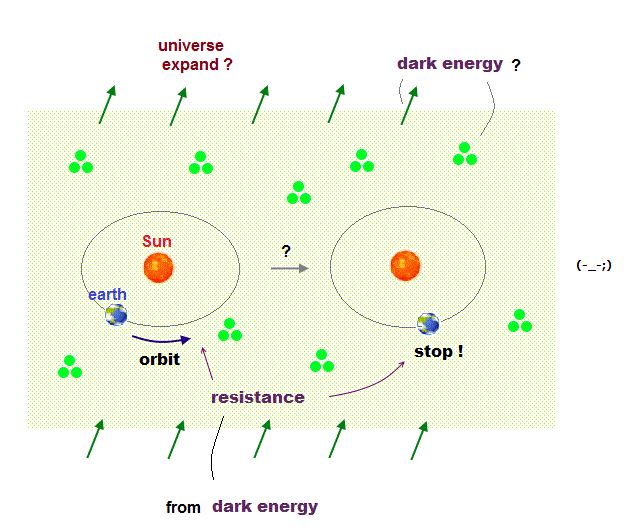
Quantum computers are impractical forever, they can never realize useful quantum computers with millions of errorless qubits.
To hide this inconvenient fact of the already-deadend quantum computer, an incredible amount of overhyped fake news is spread every day.
Actually, the media always said "quantum computers will be practical in just five years every 5 years, ← All these predictions turned out to be wrong.
This or this or this-3~4th-paragraphs say -- Fake news
"A practical quantum computer is now less than 10 years away" in 2006 (= practical quantum computer in 2016 ? ) ← Fake news because still No practical quantum computers even now in 2025.
This-headline in 2018 says -- Fake prediction
"The World's First Practical Quantum Computer May Be Just Five Years Away (= practical quantum computer in 2023 ? )" ← fake news
This-5th-paragraph (11/13/2025) says -- No practical use
"experts say the technology has yet to bring practical benefits. "
This-1st~2nd-paragraphs in 2012 say -- IBM fake news-1
"Quantum scientists at IBM Research have announced major advances in quantum computing that could place real, practical quantum computers in businesses and homes within the next 10 years (= practical quantum computer in 2022 ? ← false )."
This news in 2018 says -- IBM fake news-2
"IBM sees quantum computing going mainstream within five years (= practical quantum computer in 2023 ? this-2nd-paragraph, ← false )"
This news in 2023 says -- IBM fake news-3
"quantum computers could soon outperform classical digital computers at practical tasks in the next two years (= practical quantum computer in 2025 ? ← false )."
↑ Now IBM moved the goal posts, and started to says "practical quantum computer by 2029 ~ 2030"
All quantum computer companies such as IBM, Microsoft, Rigetti, PsiQuantum keep lying about when practical quantum computers will be realized ( this-Myth 4; quantum computers are always ten years away ).
PsiQuantum using impractical photon quantum computers with only less than 12 qubits are constantly lying " millions of qubits will be built by 2025"
↑ This PsiQuantum's prediction turned out to be wrong, so they started to say " millions of qubits by 2028" ← nonsense
Quantum computers are hopeless, far from practical, just constantly moving the goalposts about when real quantum computers will come (= never happen ).
(Fig.A) Fake quantum supremacy is based on fictional idea that qubits can give random (useless) numbers through many (unreal) parallel-universe qubits' states, which may be hard for a classical computer with a single universe to simulate.

Quantum supremacy such as Google's Willow is fake, just outputting random useless numbers with No quantum computation nor error correction.
This or this-2nd~3rd-paragraph says -- Useless quantum supremacy
"The calculation has almost No practical use—it spits out a string of random numbers.... Useful quantum machines are many years away"
This website's 7th paragraph says -- Fake quantum supremacy
"Google themselves note that RCS (= random circuit sampling ) is fairly useless, and that they have yet to demonstrate a useful algorithm where Willow (= google's latest quantum computer ) outperforms a classical computer." ← No real quantum supremacy
This-middle-Will quantum computers arrive soon ? says
"Google concedes that Willow's error rate is still too high for quantum computing to be useful in an applied setting ( this-3rd-last-paragraph )"
↑ They baselessly insist quantum computers' qubits went through (illusory) quantum superposition or parallel universes to output random (useless) numbers, which are hard for classical computers existing in one single universe to emulate, so this is quantum supremacy ! ← nonsense.
No evidence of quantum parallel universes, so No quantum supremacy from the beginning.
Chinese and Xanadu's (useless) photon quantum computer advantage based on randomly detecting photons (= weak lights ) called "boson sampling" is also fake, useless, based on unfounded parallel universes into which each photon may split at beamsplitters.
↑ This-3rd-last-paragraph says -- Error-prone fake quantum advantage
"While it may demonstrate a computational advantage for a narrow task, it lacks crucial elements for fault-tolerant and useful quantum computation,"
↑ Google's Fake quantum advantage with No useful quantum computation nor error correction.
(Fig.C) Fake quantum advantage by comparison with bad classical methods (= good classical methods easily outperform today's error-prone quantum computers ).
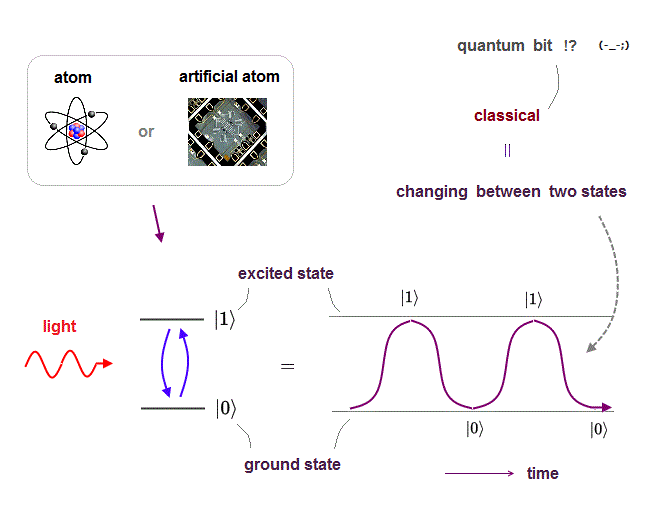
Quantum computers are useless forever, too error-prone to give right answers, and cannot be scaled up to practical million-qubit quantum computers.
So they started to disguise ordinary errorless classical computers as "hybrid quantum computers" or "quantum simulators" to calculate some quantum methods faster than bad classical methods for claiming fake quantum advantage ( this-p.1,p.3 ).
↑ So the so-called commercial quantum computers allegedly showing some (doubtful) quantum speed-up in logistics (= D-Wave scam ), AI, machine-learning, robot, medicine, cloud-service, calculating molecules, proteins, game, material design.. are just classical computers disguised as hybrid quantum simulators with No quantum computer's advantage.
This-Why classical computers still reign (2025) says -- Classical better
"in 2025 the classical computer is still king in practice... Quantum computers remain slow,. For most tasks that businesses care about – from running a database to rendering video to powering AI inferences – today's classical computers not only outperform quantum computers, they absolutely trounce them."
This-1st-paragraph (7/2/2025) says -- Useless quantum computer
"Quantum computers still face a major hurdle on their pathway to practical use cases:(= still useless quantum computers ).."
".. their limited ability to correct the arising computational errors. To develop truly reliable quantum computers, researchers must be able to simulate quantum computations using conventional computers (= classical computers used as quantum simulators, this-p.1-abstract ) to verify their correctness"
See the recent bond trading's quantum advantage is fake.
(Fig.F) "Potential application" for quantum computers is a lie.
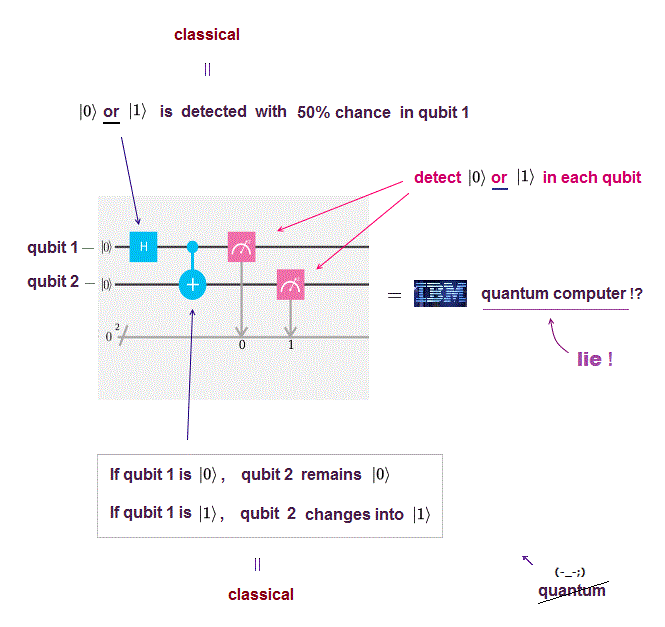
The 1st paragraph of this overhyped
news (4/21/2024) says
"Their work,.. that could enable transformative advancements in quantum computing, quantum communication and other quantum-based technologies."
↑ This research's paper's p.1-abstract says nothing about the quantum computing nor communication, contrary to this misleading title.
Also in this overhyped ( illusory ) topological quantum computer news (4/13/2025), their research paper on fictional quasiparticles says nothing about quantum computers (= so this research is irrelevant to hyped quantum computers ), contrary to the news headline.
Contrary to another overhyped news' headline (5/30/2025), this research also has nothing to do with quantum computer (← this-abstract says nothing about practical use nor quantum computers. ).
↑ In this way, there is a wide discrepancy between the overhyped fake news and the actual papers to hide the fact that today's quantum mechanics researches are deadend, impractical, needing fictional practical application.
The 9th paragraph of this overhyped news (6/30/2025) says
"The breakthrough has broad potential (= just speculation, still useless ) applications—from phones and computers that don't overheat, to quantum computers, faster medical imaging," ← hype.
↑ This research paper 's abstract and lower-3.conclusion says nothing about any above detailed practical application such as quantum computers, contrary to the hyped fake news.
↑ This research (2.methods) is just about imaginary theory of anomalous Hall effect (= electric current veers due to Lorentz magnetic force from the material, irrelevant to quantum computers ) with No experimental realization.
The last paragraph of this hyped news on quasiparticle (6/13/2025) says
"We can now simulate glass and amorphous materials,.. that can enable quantum computing bits"
↑ This research paper's abstract says nothing about quantum computing contrary to the above hyped fake news.
(Fig.S) One qubit can be observed to be one state of 0 or 1 after all. Quantum superposition of one qubit being 0 and 1 simultaneous parallel-world states is illusion.
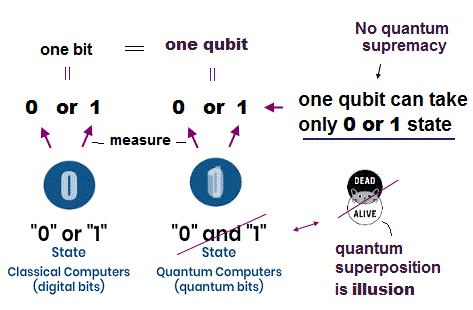
The ordinary (classical) computer consists of many bits (= transistors ), and each bit can take 0 or 1 state.
Quantum computer uses two unstable energy levels of each atom, ion or artificial atom (= superconducting classical circuit ) as a quantum bit or qubit (= each atomic qubit's ground state = 0, and excited state = 1 ).
Each qubit is just measured to be 0 or 1 bit value, so just 2 qubits (= 2 bitstring 00.. ) or 3 qubits (= 3 bitstring 001.. ) are still Not quantum computers (= practical quantum computers are said to need millions of qubits, this-4th-paragraph, this-8th-last-paragraph ), contrary to hyped misleading news.
Until measurement of qubits, this qubit is said to take 0 and 1 states simultaneously using illusory quantum superposition, a dead-and-alive cat or fictional parallel worlds, which is the basis of the illusory overhyped quantum computer's simultaneous-parallel-universe-calculation speed-up or supremacy ( this 10~11th-paragraphs, this-middle, this 4~7th-paragraphs, this-p.4, this-last-paragraph ).
But physicists can observe only one single state 0 or 1 in one single world in quantum computer bits or qubits ( this 4~5th-paragraphs, this 26~29th-paragraphs ).
So there is No evidence that a qubit can take 0 and 1 states using the magical (unrealistic) quantum superposition or parallel universes ( this p.1 ), which means No evidence of quantum computer's speed-up nor practical application.
The present quantum computers with small numbers of error-prone qubits less than only a few hundreds qubits (= one qubit can take only 0 or 1 value ) are useless, far from millions of qubits required for a practical quantum computer ( this-8th-last-paragraph, this-4th-last-paragraph ).
This-4th-paragraph says
"For a quantum computer to be practical, millions of qubits must be accommodated on a single chip. The most advanced quantum computers today have only a few hundred qubits, meaning they can only perform calculations that are already possible (and often more efficient) on conventional computers.." ← No quantum advantage
(Fig.Q) Quantum superposition is just a transient classical qubit's middle state between 0 and 1, irrelevant to fantasy quantum parallel universes.
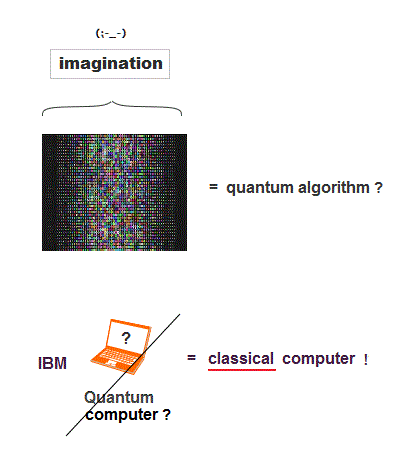
When each qubit such as a superconducting circuit and ion qubit changes its state from 0 to 1 by (classical) microwave pulse (= called Rabi oscillation ), it generates the transient middle state mixing 0 and 1 states classically, which is falsely treated as (fictional) quantum superposition (= a dead and alive cat ) or parallel universes.
In this transient state, the probability of a qubit giving 0 or 1 is the same 50% (= each qubit is always measured to be 0 or 1 instead of 0 and 1 superposition or parallel-universe states ).
↑ So the fictional quantum superposition or parallel universes just means the transient qubit state that gives 0 or 1 state with the same probability (= a dying cat that survives or dies with 50-50% probabilities ) instead of a dead (= 0 ) and alive (1) cat living in two quantum parallel universes ( this 4~5th-paragraphs, this 7th,9th-paragraphs, this p.2-right, this p.3-right-1st-paragraph, this 3rd-paragraph ).
As a result, the alleged quantum computer's speed-up or supremacy based on (unfounded) quantum superposition or parallel universes is fake, just illusion.
(Fig.C) Different superposition states in different parallel universes must interfere with each other to leave the desirable value, so No (independent) parallel universes nor superposition from the beginning (= No quantum computer's speed-up ).
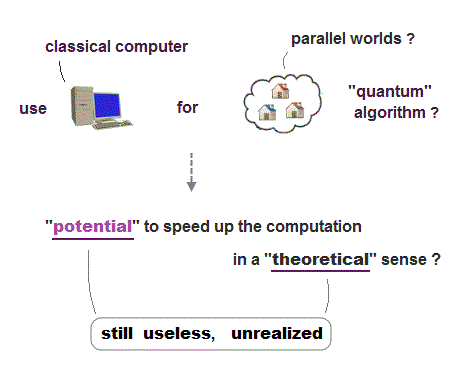
Quantum computer's (illusory) speed-up or supremacy is based on unfounded assumption that each qubit can take 0 and 1 superposition states simultaneously ( this-7~8th-paragraphs, this-2~5th-paragraphs, this-6~7th-paragraphs ) using (fantasy) parallel universes.
So they claim that a quantum computer with n qubits can take 2n different superposition states or parallel universes to calculate 2n different values simultaneously, faster than a classical computer ( this-superposition, this 4~7th-paragraphs ).
↑ But we can observe only one qubit's state 0 or 1, only one value in one single world, when measuring qubits ( this p.3-measurement ), which is called "collapse".
So even if quantum superposition or parallel universes are real, we can only get only one value at a time, and there is No quantum computer's speed-up nor advantage.
For the (illusory) quantum computer's speed-up, the 2n different superposition (= n is the number of qubits ) or 2n different parallel universes must interact or interfere with each other to conveniently give only one desirable superposition or one single world state with higher probability ( this-p.29~30, this-2.-interference, this-4~5th-paragraphs, this-What is quantum interference? ).
This 25th ~ 29th paragraphs say
"A quantum computer can be in a quantum combination of all of those states, called superposition. This allows it to perform one billion or more copies of a computation at the same time. In a way, this is similar to a parallel computer with one billion processors performing different computations at the same time"
"If we measured this quantum state, we would get just one of the results. All of the other 999,999,999 results would disappear."
"To solve this problem, one uses the second effect, quantum interference..
Quantum parallelism is used to perform a large number of computations at the same time, and quantum interference is used to combine their results into something that is both meaningful"
↑ The (illusory) quantum computer's speed-up needs the magical simultaneous calculations of different values using different superposition states or (independent) parallel universes, but these parallel universes must interact or interfere with each other (= simultaneous calculations of different values independently is impossible in these parallel universes or superposition states interacting with each other as one single world ), so No independent parallel universes (= hence, No superposition ), No independent simultaneous calculations of different values, and No quantum computer's speed-up.
↑ All different superposition or parallel universes interacting (= interfering ) with each other from the beginning means there are No different superposition or independent parallel universes, instead, there is only one state (classically) mixing different (superposition) states interacting or interfering with each other in one single world.
Instead of each qubit being 0 and 1 superposition in two different quantum parallel universes, each qubit is just one state mixing 0 and 1 states classically in one world, if quantum interference is true (= n qubits in n different states in one world instead of 2n different worlds, so No quantum speed-up ), which prevents quantum speed-up based on simultaneous calculations of many different values in different independent parallel universes or superposition states.
As a result, quantum computer's speed-up, supremacy or advantage is fake, will never happen.
(Fig.S) A superconducting (= transmon) qubit is just a classical circuit where two different electric currents' energies or frequencies represent 0 and 1 bit states.
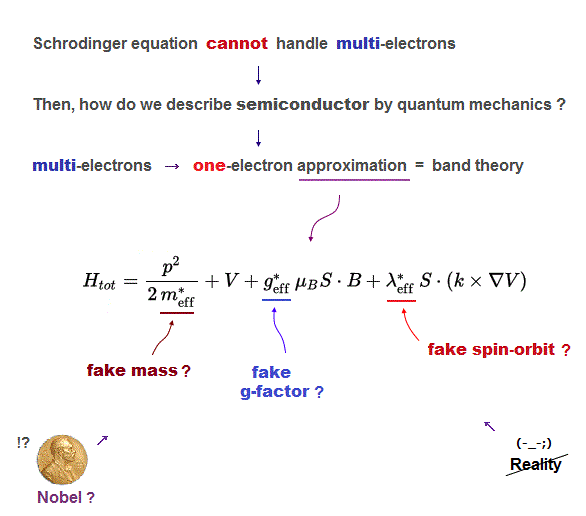
Google used a quantum computer named Sycamore consisting of 53 superconducting qubits called transmon or artificial atoms.
This superconducting transmon qubit used by major companies such as Google and IBM consists of a classical LC circuit with ordinary capacitors, inductors and Josephson junction where the different amounts of charge and current represent each qubit 0 or 1 or the middle-(fictional) superposition states ( this 4th-last~3rd-last-paragraphs ).
Cooper pairs where two negative electrons allegedly attract each other by fictional phonon quasiparticle inside superconductor (= real electrons cannot attract each other ! ) can be explained by classical electrons ( this p.4 ) attracting each other through positive nuclei (= fictional quantum mechanical quasiparticles are unnecessary ).
Each bit or qubit's 0 or 1 state can be manipulated by classical microwave ( this p.2 ).
This qubit gate operation by classical microwave pulse is said to generate (fictional unseen) quantum superposition or parallel world states of the simultaneous 0 and 1 states in each qubit, though there is No evidence of quantum superposition or parallel worlds.
(Fig.S) Quantum error correction is disastrous, impractical forever, increasing errors instead of decreasing errors !
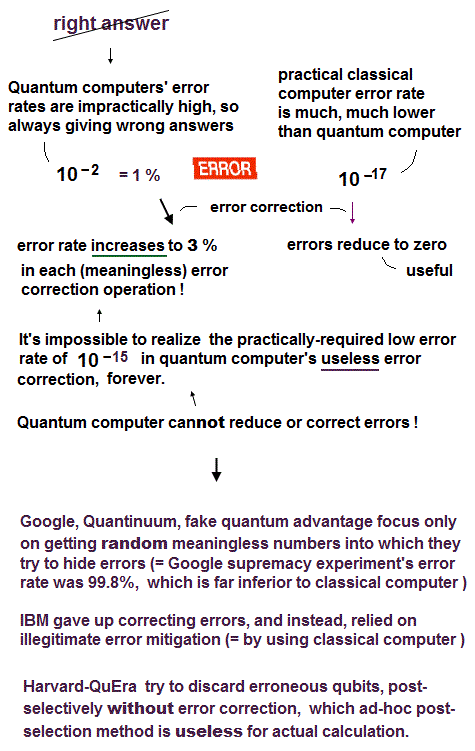
Quantum computers are said to be faster by ( fictional ) parallel-universe simultaneous calculations which have No evidence, as seen in still useless quantum computers.
All the present quantum computers are useless, too error-prone to give right answers.
This-4~5th-paragraphs (5/11/2025) say
"Qubits remain fragile. Error correction is a monumental challenge,.. Scalable architectures are still experimental – we just don't have quantum computers big enough to do anything useful !" ← Quantum computers are still too error-prone to be useful even after an incredible amount of hyped news.
This-lower road ahead (12/16/2024) says
"Quantum computing today provides No tangible advantage over classical computing in either commercial or scientific applications"
"At this stage, quantum computers have too few qubits and too many errors to be practically useful" ← Despite extremely-long years of fruitless researches, quantum computers are still impractical (forever).
This last-paragraph (11/6/2024) says
"current quantum computers are limited in size and prone to large errors. Most of these machines are Not yet useful for real-world applications "
This-below-Will quantum computers arrive soon ? (12/16/2024) says
"Google concedes that Willow's error rate is still too high for quantum computing to be useful "
This 2nd-paragraph (12/17/2024) says
"Google’s machine had No capacity for detecting and correcting errors"
The 1st-paragraph of this news (3/20/2024) says
"quantum computers are extremely sensitive to noise introduced through interactions with their environment. This noise leads to computational errors, and today’s quantum computers are too error-prone to compute the answers to problems that are of practical utility" ← Today's impractical quantum computers are too error-prone to give right answers.
Unlike the ordinary classical computers such as laptops (= with accurate billions of errorless bits ), correcting these errors in quantum computers is impossible ( this challenge 2, this 4th~ paragraphs ).
(Fig.P) Future practical quantum computer is said to need more than millions of qubits and less than 10-15 error rate, which is impossible to achieve forever.

Even the current best quantum computer's error rate of two-qubit gate operation is about 1 ~ 0.1% (= 10-2 ~ 10-3 = fidelity is 99 ~ 99.9% ), which is far worse than the ordinary practical classical computer's error rate of less than 10-17 ( this p.1-left, this 2nd-paragraph ).
Practical quantum computer is said to need far less error rate of less than 10-15 ( this 5th-paragraph, this-3rd-paragraph, this 2nd-paragraph, this abstract ), and more than millions of qubits for correcting errors ( this 19~21th-paragraphs ), which is impossible to realize forever.
↑ Today's error-prone useless quantum computer qubit's error rates = 10-2 = 10-3 ( fidelity is 99 ~ 99.9% ) are far worse than the practically-required error rate of 10-15 (= a practical qubit's fidelity must be higher than 99.9999999999999%, which is impossible to achieve forever ).
This-Why classical computers still reign-2nd-paragraph (4/18/2025) says
" The error rates of quantum gates (the basic operations) are typically on the order of 0.1% or 1% per operation, which sounds small but compounds quickly when you perform thousands of operations. By contrast, classical computers have error rates so low they're effectively negligible – perhaps one error in 1018
operations, thanks to stable hardware and error-correcting codes. The best quantum computers today might get through a few thousand operations before an error occurs. "
The recent research (1/9/2025) of this misleadingly hyped news did Not correct errors, instead, they just cooled down (= reset = Not error correction ) only 3 impractical qubits (= only 3 bitstring 001, this or this p.2-Fig.1 ) with still much higher error rate than 10-15 ( this-2nd, 12th-paragraphs ).
This 2~6th-paragraphs say
" Today’s quantum computers are noisy... This means that approximately every 1 in 100 or 1 in 1,000 quantum operations ends in an error. So you cannot trust the output of your computation."
The 8th-last paragraph of this site says
"Willow is still well too small to do useful calculations and that quantum computers will require "millions of qubits" to solve really important industry problems. Willow has 105 qubits (= just 105 bitstring cannot calculate anything )"
The 2nd, 22-23th paragraphs of this recent site says ↓
"However, a significant hurdle remains: error correction. With every step of a quantum computation, errors accumulate, ultimately leading to inaccurate results."
"If you have two nines of fidelity, i.e., 99%, one way forward is to use lots of qubits for error correction. It’s inefficient,"
"We may never achieve a physical error rate as low as 10-15, one error in a quadrillion operations, which would be comparable to modern-day transistors." ← Today's error-prone quantum computers are No match for ordinary classical computers.
This 9th paragraph says
"They're highly susceptible to "noise" (interference), which leads to computational errors. One of the most common breeds of quantum computers is described as being noisy intermediate-scale devices. They're prone to error,"
This p.5-right-last~p.6-left says
"The current error rate, approximately 10-3, significantly surpasses the 10-15 error rate
required for many quantum algorithms
to achieve computational advantages.... practical implementation of
fault-tolerant quantum computers through quantum error-correction protocols with
millions of physical qubits may require decades of
further research." ← never realized.
(Fig.E) Just one ion qubit (= one qubit can take only 0 or 1 bit value ) is still Not a quantum computer.

The 1st, 2nd, 2nd-last paragraphs of this overhyped news (7/28/2025) say
"Scientists have achieved the lowest quantum computing error rate ever recorded — an important step (= still unrealized ).. on the way to practical, utility-scale quantum computers." ← fake news
"the scientists demonstrated a quantum error rate of 0.000015% (= 10-7, which is still far worse than the error rate of 10-15 required for a practical quantum computer or classical computer, this-3rd-paragraph )"
"This isn't a panacea for the industry, however, as many quantum algorithms require multigate qubits... The error rate in two-qubit gate functions is still roughly 1 in 2,000 (= too bad )."
↑ So this research just used only one single impractical Ca+ ion qubit ( one qubit can take only 0 or 1 value ), which is still Not a quantum computer that will need millions of qubits
And the two-qubit operation error rate is still much higher = 1/2000, which is impractical ( this-3rd-last-paragraph ).
↑ This-research paper's p.1-right-last-paragraph, p.9-S1(a) used only one Ca+ ion qubit whose two energy (= hyperfine ) levels were used as one qubit's 0 and 1 bit state.
(Fig.F) Fidelity = 2% (= 0.02 ) equals error rate of 98% (= 0.98 )
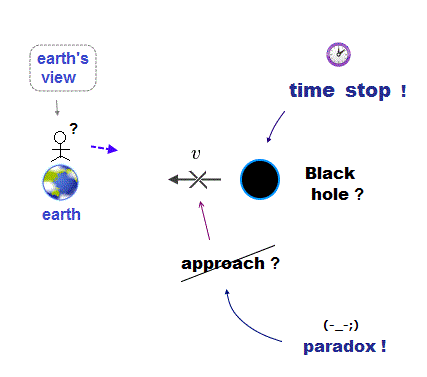
Fidelity (= F ) is the opposite of error rate.
Fidelity F = 1 - error rate ( this p.3-left-2nd-paragraph, this p.59 ).
So when the fidelity is 98%, the error rate is 2% ( this p.1-left-1st-paragraph, this 18th-paragraph ).
This 3~4th-paragraphs (or this-gate operation errors ) say
"Even with a so-called state-of-the-art fidelity of 99.9 percent, an error still occurs in one out of every 1000 operations (= error rate is 0.1% ). In the realm of quantum computing, where complex algorithms require many thousands or even millions of qubit operations, such error rates are prohibitively high. Conducting long calculations becomes practically impossible without accumulating significant errors that render the results unreliable."
"By contrast, classical computers exhibit minuscule error rates. Thanks to highly reliable semiconductor technology and sophisticated error correction techniques, classical computers achieve error rates as low as one error per quintillion operations (that's one in 1018, this p.1-left-lower )"
(Fig.S) Today's quantum computers unable to give right answers could only generate random useless numbers with 99.9% error rate to claim fake quantum supremacy.
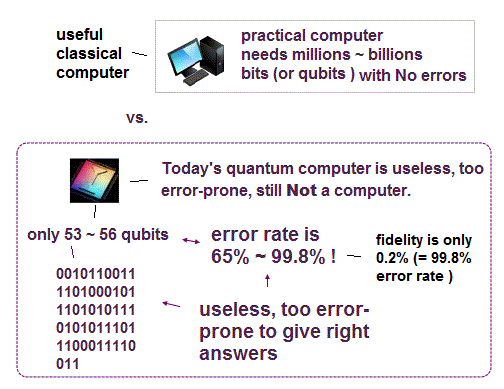
Today's quantum computers are useless, too error-prone to give right answers.
So Google 53-qubit Sycamore and 105-qubit Willow started to generate random useless numbers to claim fake quantum supremacy or speed-up.
They just output 53~105 random bitstring numbers with a lot of errors (= noise ) = their estimated error rates were as high as 99.8 ~ 99.9%, which means their (XEB) fidelity was 0.2% ~ 0.1% (= this p.3(or p.2)-1st-paragraph, this-p.7, this 6~10th-paragraphs, this p.1-below-application performance ).
↑ These random (meaningless) numbers (= called random circuit sampling, this p.1-introduction ) were just results of errors, Not of quantum calculation based on (illusory faster) quantum superposition or parallel universes.
(Fig.Q) Quantuinuum's (fake) supremacy experiment using only 56 qubits just output random meaningless numbers with error rates of more than 65%.
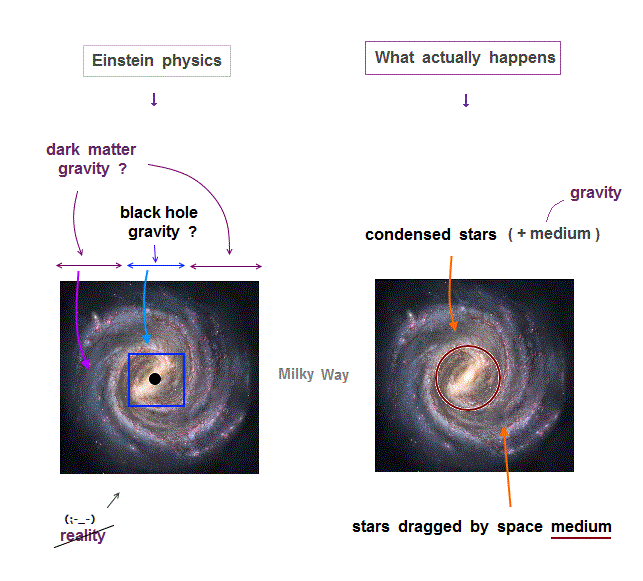
The recent overhyped Quantinuum's 56-ion-qubit quantum computer (= still Not a computer ) was also too error-prone to give right answers (= this is why they could deal with only random meaningless numbers, this-middle-The supremacy definition leaves the door open for debate ).
This headline and 7th paragraph say
"This one only produces errors 65 percent of the time." ← 65% error rate is too high to give right answers.
"The demonstration, detailed in this paper, involved an algorithm called random circuit sampling"
This 2nd-paragraph says
" Quantinuum’s new 56-qubit computer, called H2-1, ran simulations without a single error about 35% of the time (= meaning still 65% high error rate ), while Google's – 0.2% of the time (= Google's quantum computer was 99.8% high error rate )" ← This high error rate cannot give right answers nor prove quantum supremacy.
↑ Their actual error rates were probably worse than 65 ~ 99.9%, because it is impossible to know true error rates only from random meaningless numbers in today's fake quantum supremacy experiments.
This 8-9th-paragraphs ( or this 7~10th paragraphs ) say
"They used the linear cross entropy benchmark (XEB = fidelity), which produces results between 0 (completely error-prone) and 1 (entirely error-free)."
"In this quantum performance, the H2-1 (= Quantinuum's 56 ion qubits ) hit an impressive high note. It achieved an XEB score of approximately 0.35, meaning it can produce error-free results 35% of the time (= still 65% high error rate ).
".. This score is a significant improvement over Google’s Sycamore, which registered an XEB (= fidelity ) result of about 0.002 (= Google's supremacy experiment's pseudo-random numbers were just results of 99.8% error rate, Not of quantum mechanical calculation, so No quantum supremacy ) in 2019"
(Fig.Q) One logical qubit for calculation consists of multiple physical qubits. ← Even when some physical qubits cause errors, the remaining intact physical qubits can give the right logical qubit value. ← This logical qubit also failed to correct errors after all.
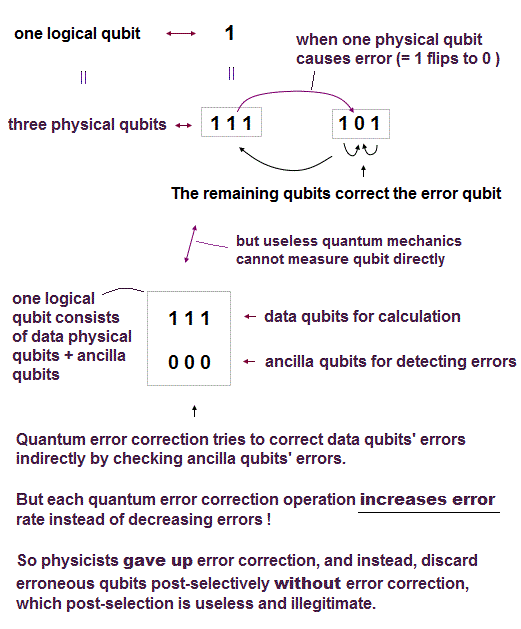
For today's error-prone quantum computers to detect errors, multiple physical (= original ) qubits must be treated as one fictitious (logical) qubit (= one logical qubit consisting of multiple qubits can take only 0 or 1 bit state ).
This or this-5th (or 6th ) paragraph says
"scientists can form one logical qubit, storing the same information (= 0 or 1 ) in all of the constituent physical qubits. If one or more physical qubits fails, the calculation can continue because the information is stored elsewhere ( this 7th-paragraph )."
So for example, the quantum computer with 250 (physical) qubits cannot use 250 qubits directly for calculation, instead, it must split the original 250 qubits into a smaller number of (fictitious) logical qubits (= For example, when 250 qubits are split into only 5 logical qubits = each logical qubit consisting of 50 physical qubits, ← This 250-qubit quantum computer can utilize only 5 qubits or 5 bitstring 00000 for calculation ).
When some physical qubits inside one (fictitious) logical qubit show errors, they try to correct these errors from the remaining intact physical qubits like a majority vote ( this 8~21th paragraphs, this p.8 ).
Think about the case where one fictitious logical qubit consisting of 3 (physical) qubits.
↑ When one logical qubit (= 1 ) is expressed by three physical qubits (= 111 ), and one physical qubit shows errors, flipping 1 into 0 like 111 → 101, the remaining intact two physical qubits are used to correct one erroneous physical qubit like 101 → 111 by majority rule = the original intact logical qubit 1 can be recovered ( this p.4, this p.4-2nd-paragraph, This 5~6th paragraphs ).
So physical qubits are used for error detection instead of being used directly for calculation.
Only logical qubits (= each logical qubit consists of multiple physical qubits ) can be used for actual calculation (= one logical qubit can express only 0 or 1 bit state, and one physical qubit alone is not allowed to express 0 or 1 bit state for calculation, this 3rd-4th paragraphs ).
In fact, the current error-prone qubits can Not implement the error correction (= even one errorless logical qubit cannot be built now ) that is said to need more than millions of qubits ( this 14~16th-paragraphs, this p.1-right-1st-paragraph ), which is impossible to realize ( this 11~21th-paragraphs ).
This-lower-challenges on the road to scale (7/10/2025) says
"Correcting these errors requires encoding a single logical qubit into many physical qubits – often thousands of physical qubits per robust logical qubit,.. today's largest machines (~1000 qubits) are still far short of the millions of qubits likely needed for general-purpose applications."
↑ Even scaling up to hundreds of qubits is impossible, as this-middle-Scalability (6/17/2025) says
"Scaling up quantum computers to hundreds or thousands of qubits while maintaining high levels of coherence and low error rates remains a major challenge"
This abstract says
"full fault-tolerant quantum computing (FTQC) based on
quantum error correction code remains far beyond realization due to its extremely large requirement of
high-precision physical qubits"
(Fig.L) One logical qubits consists of multiple error-prone physical qubits (= data + error detection qubits )

The problem is quantum computer is Not allowed to measure each qubit directly, because the measurement is said to destroy the (unobservable) quantum superposition or parallel-world state ( this p.1-left ) needed for (fictional) simultaneous calculations.
This p.2-(ii) says
"Measurement destroys quantum information. In contrast to the classical case checking for
errors is problematic. Monitoring means measuring, and measuring a general quantum state
alters it. Thus it seems that any attempt at error correction must destroy important quantum
information."
So in quantum computer, each logical qubit consists of multiple data qubits (= for storing data for calculations ) and multiple ancilla or stabilizers qubits which are 'entangled' with data physical qubits, and used for indirectly detecting errors of data qubits without destroying (fictitious) superposition states ( this p.6 ).
For example, in the upper figure, each logical qubit (= 1 ) consists of multiple (physical) qubits of multiple data qubits (= 11111111 ) + multiple ancilla qubits used only for error detection.
↑ But today's error-prone quantum computers easily cause errors not only in data qubits but also in ancilla qubits in each measurement or qubit manipulation, so accurate detection and correction of errors are impossible.
In principle, when these error-detection ancilla physical qubits are measured to be show some error flag sign (= indirectly showing errors in data qubits ), the corresponding erroneous data qubits inside the same logical qubit, which are expected to have errors, should be corrected ( this middle ).
But the qubit operation correcting errors of qubits itself causes new errors, so this ideal quantum error correction is impossible.
This measurement of ancilla qubits for indirectly detecting errors is called syndrome ( this p.7-lower-Diagnose, this p.4-right-upper ) or stabilizer measurement ( this p.2~3-Results, this p.9~14, this p.15 ).
This "Quantum error correction with surface codes" says
"Bob wants to send Alice a single bit that reads "1" across a noisy communication channel. Recognizing that the message is lost if the bit flips to "0", Bob instead sends three bits: “111 (= one logical qubit consisting of 3 physical qubits )”. If one erroneously flips, Alice could take a majority vote = error can be corrected like 101 → 111 (= a simple error-correcting code )"
"we arrange two types of qubits on a checkerboard. Data qubits (= used for calculation ) on the vertices make up the logical qubit, while measure qubits (= error detection qubits ) at the center of each square are used for so-called stabilizer (= error detection ) measurements. These measurements tell us whether the qubits are all the same, as desired, or different, signaling that an error occurred"
(Fig.C) Today's impractical quantum computers just increase their errors by error correction operation, so quantum error correction is impossible.

The serious problem is that the current quantum computers are too error-prone to correct errors.
So when physicists try to detect and correct errors by manipulating qubits, ironically, this qubit manipulation for error correction itself increases or worsens the original error rate instead of decreasing it (= error-worsening operation ).
In Google's recent error correction experiment (= actually, they did Not correct errors, this 3rd-paragraph ), one logical qubit consisted of 49 (or 17 ) physical qubits, whose error rate increased by 3.0% each time error correction operation (= cycle ) was conducted ( this 3rd-last-paragraph, this 3rd-last-paragraph ).
This 9~10th paragraphs say
"This means that a 3 x 3 surface code uses 9 data qubits, plus 8 measure qubits for a total of 17 making one logical qubit (= smaller logical qubit surface code ). A 5 x 5 surface code uses 25 data qubits, plus 24 measure qubits to make a total of 49 in one logical qubit (= larger logical qubit surface code )."
" the team found that the larger surface code (= one logical qubit consists of 49 physical qubits ) delivered better logical qubit performance ( 2.914 percent logical errors per cycle ) than the smaller surface code (3.028 percent logical errors per cycle)"
↑ It means one manipulation or cycle of detecting and correcting errors of a logical qubit increased the error rate by about 3.0% instead of decreasing errors (= error-worsening error-correction operation ).
↑ This Google research paper p.4-Fig.3-b shows logical (qubit) fidelity decreased to only 0.2 (= which means error rate increased to 80% ) after 25 error correction cycles, instead of decreasing errors.
↑ This is Not an error correction but an error-worsening operation, showing quantum error correction for decreasing errors is impossible.
Even in the Google's latest Willow treating the whole 105 (physical) qubits as one logical qubit, this logical qubit increases errors by 0.143% in each error-correction (= error-worsening ) operation.
So quantum computers are proven to be useless, unable to correct errors forever.
(Fig.E) Today's quantum error correction operation just increases or worsens the error rate.
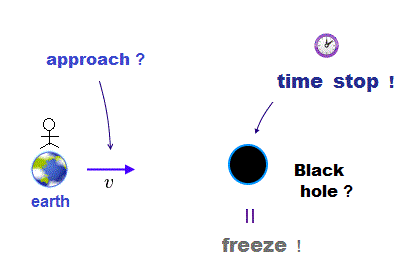
Like Google's (useless) quantum error correction just worsening errors, also in Honneywell's 10-ion-qubit experiment, the total error rate increased by 2.70% per quantum error correction operation (= QEC, this p.4-Fig.3, p.4-right-1st-paragraph ) instead of decreasing.
So error correction for decreasing or correcting errors in today's error-prone quantum computers is impossible.
(Fig.P) Today's quantum computers cannot correct errors, instead, they just discard erroneous qubits in illegitimate post-selection.
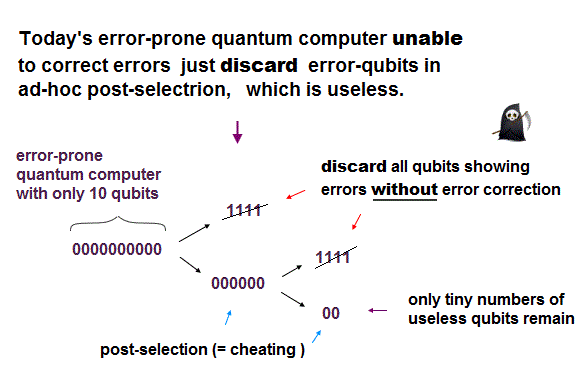
The current quantum computers are so error-prone that their error correction is impossible (= quantum error correction operation just increases or worsens errors ).
So physicists started to rely on illegitimate post-selection methods without error correction ( this 6th-paragraph, this 4th-last-paragraph ).
In this ad-hoc post-selection methods, they unreasonably discard all qubits that show errors, and post-select only qubits that can luckily avoid errors without performing error correction operation ( this p.15 ).
This p.1-left-3rd-paragraph says
"which means that
detected errors cannot be uniquely identified and corrected. We
must therefore rely on postselection to find and discard cases where
an error occurred."
This p.7-left-2nd-paragraph says
" this
experiment uses post-selection rather than correction"
This post-selection method is completely impractical.
Because in large calculations, almost all qubits in the current error-prone quantum computers show errors and must be discarded.
Only a tiny percent of qubits that can avoid errors by chance remain. ← It is impossible to calculate large numbers just by these small numbers of post-selected remaining qubits.
↑ If calculations are reset and repeated from the beginning each time some errors are detected, they can never reach final results, because errors always occur in some qubits in calculating some meaningful values. ← No practical use of quantum computers
The use of this illegitimate post-selection is seen in Microsoft-Quantinuum's ion qubits, Atom-computing, Harvard-QuEra's neutral atom qubits, all of which are too error-prone to correct errors.
The recent Caltech and Amazon quantum erasure error correction just used only two impractical qubits with No error correction.
↑ This research paper ↓
p.1-left-2nd-paragraph says "In this regime, the laser drives a unitary operation, U(t), that naturally results in the two atoms forming a Bell state, Ψ = gr + rg , between the ground (= g ) and Rydberg (excited) states (= r )"
↑ They used only two atoms as two qubits, each atomic two energy levels excited by laser light meant a qubit's 0 (= g ) or 1 (= r ). ← This ground state (= g ) was the first excited state (= P ) instead of true lowest-energy ground state (= S = treated as erasure error state ).
p.1-left-last-paragraph~p.2-top says "This Bell state generation (= one atom is g state, the other atom is highly-excited Rydberg r state ) has several major practical limitations. Of particular interest here are leakage errors to the absolute ground state S, which are converted to erasure errors in our work" ← The atomic energy levels going down to the lowest ground state (= 1S0 or a ) from g or r were treated as "erasure error".
p.2-Fig.1-right-upper says "We can discard data from pairs where atoms are detected in the erasure-error image, termed erasure excision." ← error qubits (= falling down to the lowest-energy |a> state called erasure error ) were discarded instead of being corrected. ← No error correction
Fig.1c shows the fidelity of the raw data without discarding erroneous qubits (= purple ) was very bad = 0.94 (= error rate was as high as 6% in just one two-qubit operation, which is impractical ).
p.2-right-3rd-paragraph says "While Bell state generation as demonstrated here is Not a computational two-qubit quantum gate" ← This experiment just excited two atoms by laser light with No legitimate two-qubit gate operation for computation.
p.5-left-1st-paragraph says "Besides our current demonstration of about 0.999 SPAM-corrected two-qubit fidelity," ← still error rate was 0.001 (= 1 - 0.999 ) or 0.1%, which was much higher than practically-required error rate of 10-15, so useless.
↑ This SPAM (= state preparation and measurement ) -correction is Not a true error correction but just discarding or ignoring the erroneous or lost atomic qubits in the imaging process ( this p.7-Fig.5-upper ).
↑ The 9th paragraph of this news on this research just says
"The Caltech team claims that removing and finding flaws (= instead of correcting errors ) in their Rydberg atom system may (= just speculation ) enhance the overall rate of entanglement or fidelity. According to the latest study, only one in 1,000 pairs of atoms failed to become entangled." ← Error rate of 1/1000 in each operation is still too high.
See IBM 127-qubit quantum computers showed No advantage
(Fig.D) Quantum computers with small numbers of qubits and high error rates are Not useful calculators at all. ← Quantum computer's drug discovery will never happen.

The current quantum computers are useless (= useless forever contrary to the overhyped news ), too error-prone to calculate any meaningful values.
This 5th-paragraph says
"Quantum processors remain too error-prone to demonstrate real-world advantages over classical approaches to solving practical problems."
This (or this ) 2nd-paragraph says
"Quantum computing today provides No tangible advantage over classical computing in either commercial or scientific applications ( this 1st~7th-paragraphs )"
This is why physicists had to create ( deceptive ) hybrid quantum-classical method ( this p.2 ) such as variational quantum eigensolver (= VQE ), which is substantially a classical computer, and the useless quantum computer (= far inferior to classical computer ) can do nothing.
The overhyped media often mentions this (classical) hybrid computer as (fake) quantum computers' simulation.
For example, this overhyped quantum computer's simulation of some impractical theory (3/25/2025) used the misleading hybrid computer VQE method (= almost classical computer ) with only 4 ~ 5 error-prone ion qubits (= still Not a quantum computer, this-Fig.1d. = the exact purely classical computer's simulation was also conducted. this-p.2-Fig.1f ) .
This-4th-last-paragraph says
"We're not quite ready to run this system on today's quantum computers, as the error rates are still a bit too high" ← Even the proposed hybrid classical-quantum computer is still a pipe dream ( this p.7-outlook-last-paragraph ).
So when the overhyped media (falsely) claims quantum computers calculated something faster than classical computers, it often means classical (= Not quantum ) computers' simulations of some quantum methods outperforming some deliberately-chosen slow classical methods (= Not that today's error-prone quantum computers outperforming classical computers )
The 2nd, 5th-last paragraphs of this news (1/2/2025) say
"Quantum computing is advancing, but it still hasn't been harnessed to solve real-world problems that classical computers can't." ← No quantum advantage.
"It's also still unclear which optimization problems quantum algorithms can actually solve more efficiently than classical computers."
Even in hybrid computers, physicists often rely only on the error-free 'quantum simulators' which are just classical (= Not quantum ) computers, and far better than today's error-prone quantum computers.
This p.1-left- says
" The Variational Quantum Eigensolver (VQE) is a hybrid
quantum-classical algorithm (= classical computer is necessary ) to obtain the ground state energy..
..This hybrid quantum-classical approach is deemed
promising in the current era, where quantum computers are
still error-prone and limited in number of qubits" ← quantum computers are still, error-prone, useless.
The 6th, 11th paragraphs of this site say
"The VQE (= hybrid variational quantum eigensolver ) works by using a quantum computer to prepare a quantum state and measure its energy (= quantum computer just measures something with No calculation ), then using a classical computer to adjust the quantum state in an attempt to lower the energy (= classical computer calculates and finds the lowest energy )"
"Despite the promise of VQAs, there are still many challenges to overcome. One of the main challenges is the noise and errors that are prevalent in today's quantum computers. This noise can cause the quantum part of the algorithm to produce incorrect results" ← Quantum computers are too error-prone to be useful.
The 16th paragraphs of this site says
"Today’s most popular hybrid, an algorithm known as a variational quantum eigensolver (VQE), uses classical computers to approximate a molecule's stable ground state,.. Then a quantum computer takes over to find the ground state’s precise solution. But today's error-prone quantum computers typically struggle with VQEs...
That approaches but still falls short of the classically modeled pentacene" ← No quantum advantage.
(Fig.H) Hybrid quantum-classical computer for molecular calculation is just a classical (= Not quantum ) computer. ↓
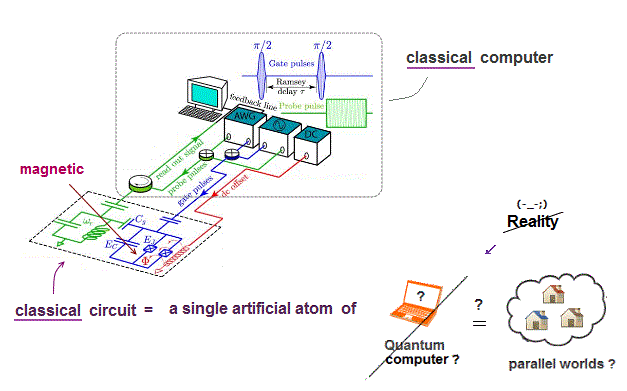
More than millions of qubits are necessary to achieve true quantum advantage ( this-4th-paragraph, this 1st-paragraph ), which is impossible in today's useless quantum computer with far smaller numbers of qubits.
This 2nd-paragraph says
"It is said that a quantum computer with a scale of 1 million qubits is needed to realize ultrafast calculations that are impossible with conventional computers,
such as quantum chemical calculations."
The 1st, 7th, 10th paragraphs of this news say
"But so far none have conclusively achieved quantum advantage"
".. Small is key because estimates indicate that a world-changing quantum computer will need one million to 10 million qubits"
"Companies that are exploring this technology have popped up in the past few years, including Alpine Quantum Technologies (which has a computer with 24 qubits), IonQ (which has 29 qubits) and Quantinuum (which has 32 qubits)" ← far from millions of qubits required for quantum advantage.
So this kind of news falsely claiming quantum advantage just by outputting random useless numbers using only 56 error-prone qubits is overhyped fake news.
All news about quantum computers for molecular energy calculation or drug discovery is just hype, and fake.
As I said, today's quantum computers are too error-prone to calculate any molecular energies or discover drug.
So they fabricated deceptive quantum-classical hybrid computers, which are substantially classical computers (= with billions of errorless bits ), and the error-prone quantum computers with only small numbers of qubits (= just 2 ~ 12 qubits, this p.2-Fig.1 ) can calculate nothing.
This 5~6th-paragraphs say
"VQE is a hybrid algorithm designed to use a Quantum Processing Unit (QPU) and a Classical Processing Unit (CPU) together"
"However, qubit-based VQE is currently only implemented up to 2 qubits in photonic systems and 12 qubits in superconducting systems, and is challenged by error issues that make it difficult to scale (← this research just used only 2~4 useless qubits, which are still Not quantum computers, this p.1-abstract )"
This IBM-Cleveland clinic's alleged 7 amino acid calculation (= based on the deceptive hybrid method heavily relying on classical computer ) used only less than 10 impractical qubits (= each qubit can take only 1 or 0, so this is just 10 bitstring, which is still Not a quantum computer ).
(Fig.H) Just 2 (or 3 ) ~ 8 error-prone bits or qubits is Not a (quantum) computer at all.
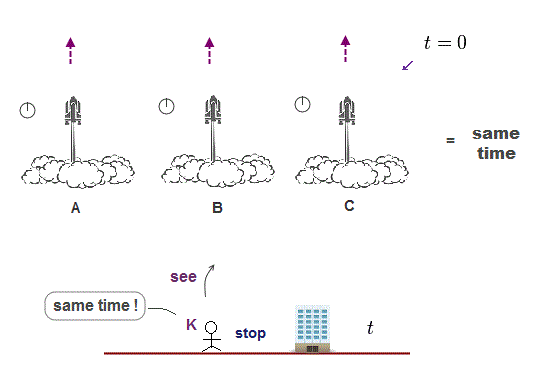
The 3rd, 5th, 7-8th paragraphs of this recent hyped news say
"Quantinuum claims this is an “essential step” to speed up the discovery of molecules and reduce the time to generate commercial and economic value in the future (= still unrealized )."
"However, these quantum machines are so sensitive that their calculations suffer from errors. Imperfect control signals, interference from the environment and unwanted interactions between quantum bits – qubits – can lead to "noise" that disrupts calculations." ← quantum computers are too error-prone to give right answers."
"In a preprint study, the team claims to have overcome the challenge by using an error-detection code which saves quantum resources by immediately discarding calculations if the code detects qubits that have produced errors." ← discarding erroneous qubits post-selectively instead of quantum error correction.
"The team used this code to make three logical qubits (= only 3 qubits or 3 bitstring 001, which bit number is too small to calculate any molecular energy )"
↑ This Quantinuum research paper ↓
p.4-left-III-1st-paragraph says
"In this
work,.. encode four logical qubits... leading to
eight qubits used in total (= just 4 ~ 8 qubits can Not calculate any molecular energy )."
p.5-left-last-paragraph says ".. to calculate the coefficients of the spin Hamiltonian (1) on classical computers. The classical pre and post-processing for parameter selection (= almost all molecular energy calculation was done by classical computer, Not by the impractical quantum computer with only 3 ~ 8 ion qubits )"
Another recent research ( this Fig.2, p.3-right-3-paragraphs ) also used only 6 ~ 8 useless qubits (= still Not a quantum computer ) in hybrid VQE that is just a classical computer (= this research used noisy-type emulator = classical computer's simulator instead of Quantinuum H1 hardware, this-Fig.2c )
(Fig.P) Just one useless ion trapped in Paul trap (= external electromagnetic field) has nothing to do with simulating chemical reaction, photosynthesis nor quantum computing, contrary to the overhyped fake news. ↓

Insider Brief of this hyped news (5/15/2025) says
"demonstrated the first quantum simulation of real molecular chemical dynamics, using a single trapped-ion quantum computer"
↑ Just a single ion qubit is still Not a quantum computer at all, let alone simulating chemical dynamics ( this-p.2-Figure 1e ).
The otter news sites spread overhyped news that researchers used a quantum computer to observe some chemical reaction called conical intersection related to photosynthesis.
But this is completely false.
Quantum computer is completely useless and unable to simulate any meaningful chemical reactions.
↑ This research paper ( this ↓ ).
p.2-Figure 1-g says "in an ion-trap quantum simulator with a single 171Yb+ ion (= only one single ion qubit 0 or 1, Not a computer or simulator at all )."
p.7-Experimental setup says "The 171Yb+ ion (= only one ion ) is confined in a Paul trap.. We use two laser beams derived from a 355 nm pulsed laser to coherently control the qubit"
↑ This research just trapped only one single (impractical) ion by controllable external electromagnetic field called Paul trap, and manipulated the ion by two laser light.
That's all. No quantum computing nor simulation of chemical reaction was done, much less photosynthesis (= just one single bit or ion can Not calculate nor simulate anything ).
Conical intersection is a very vague (useless) concept of two energy states intersecting ( this p.8 ).
The 4th, 6-7th paragraphs of this hyped news say
"the researchers used a quantum computer to distinguish adenosine from the other three nucleotide molecules (= false, Not a quantum computer but electrodes measuring electric conductance through nucleotides distinguished or identified the kinds of nucleotides )."
"The researchers used electrodes (= Not a quantum computer ) with a nanoscale gap between them to detect single nucleotides. The output of current versus time for the adenosine monophosphate nucleotide differed from that of the other three nucleotides"
"Variations in (electric) conductance depend on molecular rotation patterns that are unique for each nucleotide"
↑ This research tried to connect this electrode with only 3 impractical (superconducting) qubits with high error rates.
As shown in this p.15-2nd-paragraph and p.16, the success rate of identifying nucleotides by these 3 impractical qubits (= connected to electrodes ) was only 77.8% (= error rate was 22.8% ), which was worse than the success rate 95% of the quantum simulator (= which is classical computer ) connected to electrodes.
↑ Quantum computer was useless with No advantage.
(Fig.H) Today's quantum computer is useless, too error-prone with too small numbers of qubits to use for health care, contrary to overhyped news.

Contrary to an incredible amount of overhyped fake news, today's quantum computers are completely useless, too error-prone with too small numbers of qubits to use for health care or medicine.
So corporations and academia try to combine ordinary practical classical computers with still-impractical quantum computers as (deceptive) hybrid computers to make the hopeless quantum computers look promising in healthcare or drug development in hyped news.
This 1st~2nd paragraphs say
"Although quantum processors exist today, they are still a long way off from becoming practical replacements for classical computers... IBM has now pitched the idea of a hybrid quantum-classical computer."
"IBM readily admits that nobody has yet demonstrated quantum advantage" ← Quantum computer advantage is fake.
This-lower-Noise and error correction says
"To address this challenge the industry is exploring hybrid approaches of combining classical and quantum computing (= this is substantially a classical computer )"
This p.5-2nd-paragraph-lower says
"However, implementing quantum computing in
drug discovery faces practical challenges... To address this, researchers are developing hybrid quantum-classical
algorithms, such as the Variational Quantum Eigensolver (VQE, this 3rd-paragraph )."
This p.2-4th-paragraph says "Specialized quantum computing systems allow thousands of physical qubits, but this is still short of quantum advantage and does not make classical computing redundant"
This-p.2-left Impact of quantum computing on healthcare and biomedical research says
"However, it remains an open and crucial question as to whether QCs (= quantum computers ) can more efficiently solve problems that are intractable for classical computers" ← No quantum computer advantage.
The 2nd-last paragraph of this overhyped news also admits
"However, we still have to wait a lot until any of this can be applied in real life, so this is rather science fiction at the moment" ← quantum computer for healthcare is still science-fiction.
↑ Quantum computers useless for any applied science such as healthcare need overhyped fake news ↓
The research shown in the 2nd-paragraph (= Mathematics ) of this hyped news did Not use quantum computers, contrary to hypes.
↑ This research paper mentioned in the upper news ↓
Abstract says "To execute the grid search, our research employed a classical optimiser (= this research used a classical computer, Not a quantum computer, contrary to hyped news )"
This p.5-3.2 (= hybrid quantum-classical algorithm ) p.7-Figure.2 and p.8-4.2 (= Experimental design ) says "The authors proceeded to train a VQC (= hybrid classical-quantum ) as a classifier within Qiskit (= classical computer simulator of qubits, Not a quantum computer ) machine learning principles."
↑ As a result, contrary to various hyped news, No quantum computers (= error-prone and having only small numbers of qubits ) were useful for molecular energy calculation nor health care.
They relied on classical computers for almost all calculations as the deceptive "hybrid" computers.
(Fig.A) ↓ Quantum computer's diagnosis of Alzheimer is just hype and fake.
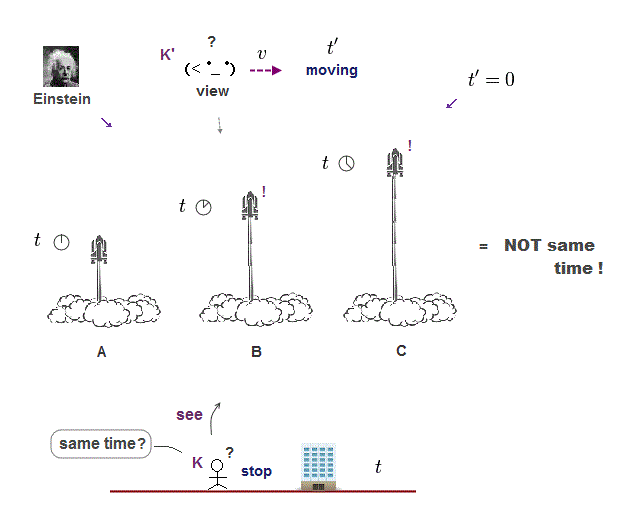
Insider Brief, the 4th-last~last paragraphs of this hyped news on the alleged quantum computing for Alzheimer's diagnosis say
"A hybrid classical-quantum (= which is substantially a classical computer, and the useless quantum computer could do almost nothing ) approach might (= just speculation, still useless ) boost the accuracy and efficiency of Alzheimer’s disease diagnosis."
"The experiments were conducted using a Hewlett Packard Core i5, sixth-generation computer with 8 GB RAM, and a Google Colab Pro GPU (= this research used ordinary classical computers for almost all calculations )."
"..On the quantum side, the researchers relied on a 5-qubit (= just 5 qubits or 5 bitstring 01101 is useless, unable to calculate anything, Not a quantum computer at all ) quantum hardware or simulator (= using classical computer for simulating imaginary quantum computer ), employing the QSVM model from the Qiskit library"
"However, the researchers acknowledge the need for further studies to evaluate the practical implementation of this model within medical devices (= still impractical )"
↑ This research paper on the dubious quantum computer on Alzheimer ↓
p.3-Methods say "In this paper, we introduced a method based on ensemble learning and quantum machine learning classification algorithms (= quantum algorithms do Not mean the use of quantum computers ) that analyze MRI brain images and extract meaningful features for successful classification of AD stages"
p.8-Conclusion and recommendation say "We used 5 qubit quantum hardware (= just 5 qubits is useless, Not a computer ) or simulator (= classical computer simulator of imaginary quantum computer was also used ) and we utilized the QSVM model from the Qiskit library "
↑ This research used only 5-qubit quantum computer (= each qubit takes 0 or 1, so 5-qubits can express only 25 = only 1 ~ 32 numbers which can be easily calculated much faster by the ordinary classical computer, so quantum computer is completely unnecessary for this alleged Alzheimer diagnosis ).
Actually this research also conducted the classical computer's simulation of the imaginary 5-qubit quantum computer by Qiskit algorithm of QSVM (= quantum support vector machine, this p.7, this p.27-2nd-paragraph~ simulators ).
This classical computer simulator of the imaginary quantum computer is usually far better than the actual (useless) error-prone quantum computer ( this p.6-right-Table 4 shows the IBM QASM classical computer simulator was much faster than the IBMQ_16_Melbourne quantum computer ).
As a result, the quantum computer with only a small number of qubits (= only 5 ) is completely useless for Alzheimer diagnosis, contrary to the overhyped news.
This recent overhyped research (2024) ↓
p.11-3.2 says "Due to limited accessibility to real quantum hardware, computation of kernels is simulated without noise on a classical hardware (= an ordinary classical computer was used in this research ), using tools from Qiskit library."
p.11-3.2 also mentions this research used only 6 ~ 12 qubits (= one qubit can take only 0 or 1 values, so just 12 qubits or 12 bitstring is still Not a computer ) simulated by classical computer (= Qiskit ), Not executed by today's (error-prone, useless) quantum computers.
It is impossible for today's error-prone quantum computers with only small numbers of qubits to calculate or simulate some meaningful physical phenomena.
So all the dubious news about the alleged quantum simulators is just fake, untrue and useless.
(Fig.Q) All types of quantum computers are extremely error-prone, unstable and impossible to scale up.
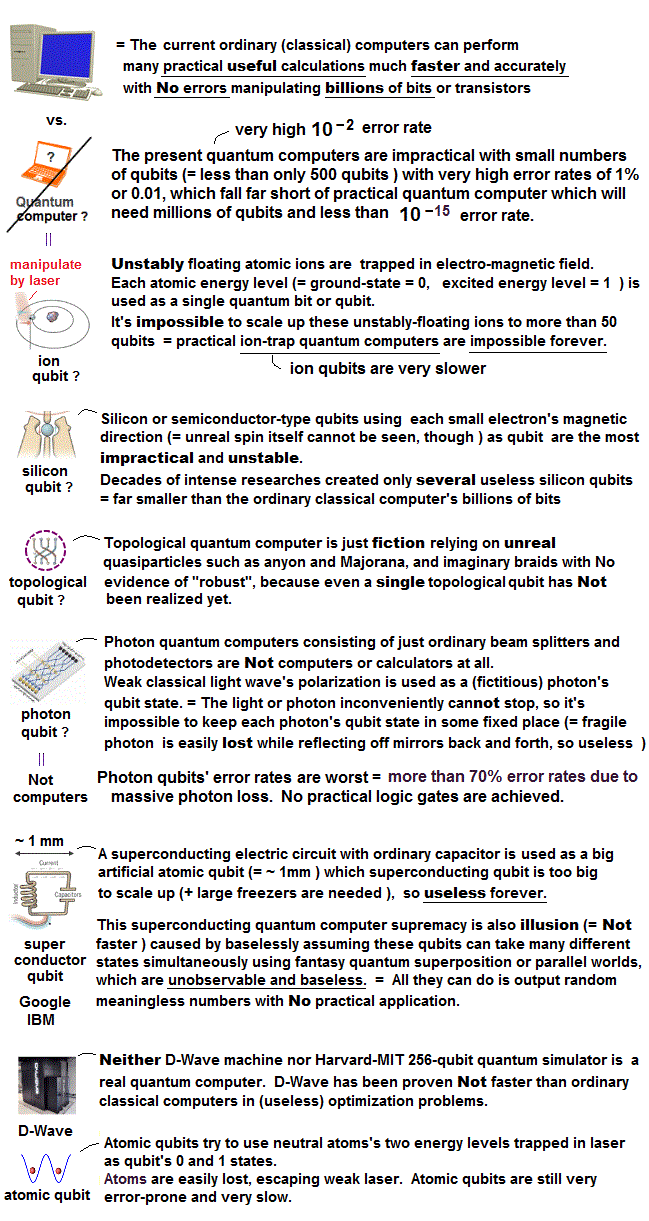
See this page.
Most major companies such as Google and IBM focus on another-type quantum computer using superconducting qubits (= just classical circuits ) which also cause impractically-high error rates ( this 5th-paragraph, this p.1-introduction-2nd-paragraph ), and the necessity to always cool their bulky qubits (= each qubit is as big as millimeter ! this 3rd-last-paragraph ) to almost absolute zero makes it impossible to realize the (imaginary) practical quantum computers that will need millions of qubits ( this 4th-paragraph, this 4th-paragraph ) forever.
D-Wave annealing machines for optimizing problems are Not true quantum computers nor faster than classical computers.
Topological quantum computer trying to use an illusory quasiparticle with fractional-charge called anyon or Majorana is unreal, fraudulent and impractical forever, Not achieving even a single qubit yet.
↑ The latest topological quantum computer is fake and unable to realize the true fault-tolerant quantum computer based on imaginary braids (= unseen non-existent braids ) at all ( this 9~10th paragraphs ).
The recent hyped news claimed that MIT researchers created (only) two qubits of new type of superconducting qubit called "fluxonium ( this Fig.1 )" whose two-qubit-gate error rate is 0.001 (= 99.9% accuracy or fidelity, this 6th-paragraph ), which is still far worse than classical computer and the (illusory) practical quantum computer whose error rate must be less than 10-15 ( this 5th-paragraph, this 3rd-paragraph, this 7th-paragraph ), and the practical quantum computer will need at least millions of qubits ( this 19-21th paragraphs ) which is impossible to realize forever.
↑ In fact, this fluxonium qubit studied by MIT is Not new. However, No quantum computer companies wanted to replace their conventional transmon (= classical superconducting circuit ) qubit by this fluxonium qubit ( this 2nd-last~3rd-last paragraphs, this p.1-right-2~3rd paragraphs ).
Because this allegedly-new-type of fluxonium qubit is much more complicated ( this 5th-paragraph ) and much slower than the conventional transmon qubit, hence scaling up or increasing the number of these fluxonium qubits is impractical and impossible ( this 2nd-last-paragraph, this-last~10th-last paragraphs, this p.2-left-2nd-paragraph ).
This is why even the latest MIT overhyped research in 2025 made only one (impractical) fluxonium qubit ( this p.3-Fig.1 = No progress ), whose two-qubit error rate remains too high, unchanged ( this 4th-last-paragraph ).
↑ The time needed to operate two-qubit (= CZ ) gate in fluxonium qubits is about 2~3 times longer (= which means 2~3 times slower than conventional transmon qubit. fluxonium two-qubit's gate time is 85 ~ 200 ns, this last paragraph, this p.7-left-2nd-paragraph,Fig.4, this p.1-right-lower ) than the conventional transmon qubits whose gate time is 20~35 ns ( this p.2-left, this Fig.1b, this p.2 ). ← No advantage, and hopeless situation of quantum computers is unchanged.
See this page.
The 1st, 4th, 10th, last paragraph of this hyped news say
"Researchers at ETH have managed to trap ions using static electric and magnetic fields and to perform quantum operations on them. In the future (= just speculation, still useless ), such traps could be used to realize quantum computers with far more quantum bits"
"In this way, it has been possible in recent years to build quantum computers with ion traps containing around 30 qubits (= far less than millions of qubits required for useful quantum computer ). Much larger quantum computers, however, cannot straightforwardly be realized with this technique (= deadend ). The oscillating fields make it difficult to combine several such traps on a single chip,"
" A single trapped ion (= only one ion qubit, which is Not a computer at all ), which can stay in the trap for several days, could now be moved arbitrarily on the chip, connecting points "as the crow flies" by controlling the different electrodes"
"As a next step, Home wants to trap two ions (= meaning this research just trapped only one ion qubit = Not a computer at all ) in neighboring Penning traps on the same chip.. This would (= just speculation ) be the definitive proof that quantum computers can be realized using ions in Penning traps (← false. Several ion qubits alone cannot prove quantum computers )"
↑ This research just trapped only one Be+ ion (= whose two energy levels were used as a bit or qubit's states 0 or 1 ), and moved it a little by controlling external electromagnetic field in Penning traps, and No quantum computer was realized, contrary to the overhyped headline "larger quantum computers".
Ordinary ion quantum computer (= still Not a computer ) can Not have or confine more than 32 ion qubits to one chip or one trap area, hence, they have to inconveniently move each ion to another Penning trap (= impractical, taking much time ) to realize interactions between more ions ( this-13-14th-paragraphs, this p.1-left-1st-paragraph, this p.1-left ).
↑ Even this latest research could trap only one ion (= just only one quantum bit or qubit 0 or 1 ) in very large bulky trap chip (= one qubit size is as large as 100μm, ~ 1mm far bigger and bulkier than the ordinary classical computer's compact bit or transistor of only 40nm size ), and move it slightly (= about 50μm ) slowly (= each motion took 4 milliseconds ) at cryogenic temperature (= 6.5K = impractical ) with No quantum computer's calculation.
Practical quantum computer is said to need more than millions of qubits ( this-1st-paragraph, this-2nd-paragraph, this-3rd-paragraph ), so the current ion-trap quantum computer, which can Not have more than 30 qubits, is completely hopeless like all other quantum computers.
↑ This research paper ↓
p.1-right-last-paragraph says "a single beryllium
Be ion confined in electric trap (= only one impractical ion qubit )"
p.2-Fig.1 shows one ion qubit is very big and bulky (= more than 100μm )
p.4-left-2nd-paragraph says "an ion was transported (= about 50μm ) in 4ms"
p.6-left-lower says "temperature of 6.5 K."
↑ Despite longtime researches across the world, practical quantum computers that will need millions of qubits are still a long way off (= which means unrealized forever ), and their quantum computer researches are regressing to only one (impractical) qubit instead of progressing to larger numbers of qubits with less errors.
Silicon-type quantum computers allegedly using a tiny electron spin dot as a qubit is far more impractical than other-type qubits. ← They only achieved highly-impractical 12-qubits, which fall far short of the practical quantum computer requiring millions of qubits ( this-lower Disagreement with Intel, this 10th-paragraph ).
↑ This silicon-type quantum computer (= still Not a computer at all ) just measures the atomic energy state or magnetic field ( this Fig.4 ) interacting with light ( this Fig.4 ), they can Not directly measure the (fictional) electron's spin itself.
Even the latest published spin-qubit quantum computer's research used only six electron qubits (= correctly, only two qubits consisting of six quantum dots, this 4th-last paragraphs, this Fig.2 ), which is far from the practical quantum computer needing more than million qubits ( this 2nd-last-paragraph, this 3rd-paragraph ).
↑ And their error rate of two-qubit CNOT gate is impractically high = 3.7 % (= 3.7 × 10-2 = 100 % - fidelity 96.3 %, this-abstract, p.4-Fig.4, this 3~5th-paragraphs ), which is also far from the practically-required error rate of 10-15 ( this 3rd-paragraph, this last-paragraph ).
The latest single-electron charge qubit ( = each electron's motion pattern is used as quantum bit's state 0 or 1 ) also has impractically high error rate (= single qubit's read out error is about 2% = 100-98% fidelity, this p.2-left ), and they did Not state the two-qubit error rates because the stable two-qubit gate operation is impossible.
See this page.
This-lower-The road ahead (3/24/2025) says
"There is still a long way to go to large-scale computation (= far from practical ). Our demonstration was on a (only) two-qubit system and using a particular type of defect"
↑ Despite decades of fruitless researches, nitrogen-vacancy in diamond (= using just some atomic energy levels without electron spin as a qubit 0 or 1 ) can Not increase the number of qubits from just 2 (= one qubit can take only 0 or 1, so 2 qubits 01 are useless, still far from a computer ).
↑ This-paper-p.7-Fig.4 (or this-p.6 ) used only 2 atomic qubits (= 01, still Not a computer ) with impractically-high error rate (= more than 50% error rate, fidelity decreased to 0.4 )
This-lower-Disadvantaeg of diamond NV center qubits (2025) says
"Scalability Issues: It is difficult to control and manipulate large numbers of NV centers in a single diamond, which makes scaling challenging ( this-middle challenges and the road ahead ).
Error Rates: NV center qubits have relatively high error rates compared to other qubit types, which limits their effectiveness for certain applications."
The 1st-3rd paragraphs of this recent overhyped news (6/12/2025) just vaguely says
"Quantum Brilliance, a company based in Germany and Australia, has outlined an ambitious plan (= still a pie-in-the-sky plan ) to develop portable quantum computers using diamond-based quantum processing units (QPUs)."
"These devices are being designed to operate at room temperature and may (= just speculation, still useless ) eventually be integrated alongside GPUs"
"But while the company's vision promises a future where quantum computing is as seamless as plugging in a GPU for AI inference, several technical and commercial hurdles remain."

"No measurable reduction of the coherence time for one- and two-qubit operations" ← so this research used only one or two qubits (= one qubit can take only 0 or 1 value, so still Not a computer, let alone millions of qubits nor hyped scalable computers ).
↑ This research paper ↓
p.1-abstract-lower and p.2-Fig.1, p.3-Fig.2. p.4-Fig.3, p.5-Fig.4 used only a single ~ 2 useless qubits (= P1, P2 ) with still high error rate at impractically low temperature, contrary to hypes.
The 1st, 4th paragraphs of this hyped news (7/2/2025) say
"For the first time, an international team of scientists has experimentally simulated spontaneous symmetry breaking (SSB) at zero temperature using a superconducting quantum processor. This achievement, which was accomplished with over 80% fidelity (= 20% error rate, too error-prone ), represents a milestone for quantum computing and condensed matter physics."
"The system began with a flip-flop configuration of alternating spins (= 010101.. ) and evolved spontaneously, reconfiguring itself with spins aligned in the same direction (= 111111.. ). "
↑ This research paper ↓
p.3-Fig.2 shows this research used only 7 impractical qubits (= one qubit can take only 0 or 1 value, so this just 7 bitstring is still Not a quantum computer ), which can be easily simulated by a classical computer (= No quantum compute advantage ).
p.5-right-1st-paragraph says "digitization of our 7-qubit scheme provides a final accuracy of around 80%."
↑ Just flipping 7 bits or qubits from 0101010 into 1111111 caused high-error rate of 20%, which is a completely useless quantum computer, contrary to hypes.
The 1st and 2nd paragraphs of this hyped news (7/2/2025) say
"Despite being powerful and fast, quantum computers still face challenges on their pathway to practical use cases. These devices have a limited ability to correct the arising computational errors." ← quantum computer is still error-prone, useless.
"Now, a team including researchers from multiple universities has unveiled a method for simulating specific types of error-corrected quantum computations "
↑ So this research just simulated some illusory quantum computer's superposition (= fictional parallel universe ) state by a classical (= conventional ) computer ( this-1st~2nd-paragraphs, this-4~7th-paragraphs ), so this research is irrelevant to the hyped quantum computer's technology (= No quantum computers were used in this research )
The 2nd, last paragraphs of this hyped news (7/8/2025)
says
"Longer qubit coherence allows for an extended window of time in which quantum computers can execute error-free operations"
"moving the needle forward on what can be made possible with the quantum computers of the future (= still unrealized now )"
↑ This research paper's p.2-Fig.2 shows this research used only 4 bulky qubits (= one qubit can take only 0 or 1 value, so still Not a quantum computer. Furthermore, this one qubit is more than 1mm, too big to be practical ).
↑ This research oscillalted just 4 superconducting (= transmon ) qubits between two energy states for 1ms (= called coherencce time ) by microwave pulses without conducting any quantum computation.
See other overhyped fake news on hopeless quantum computers.

Feel free to link to this site.